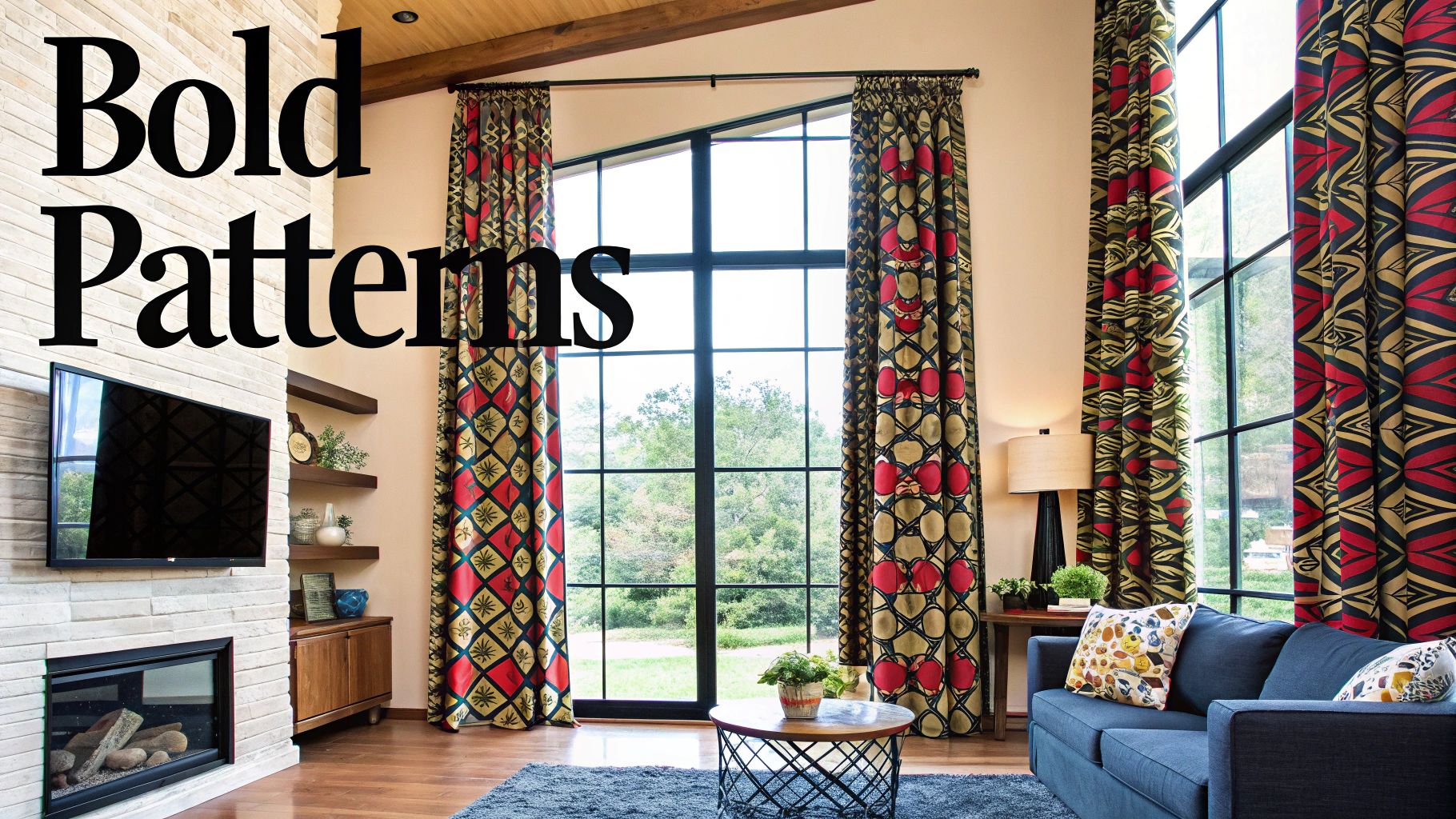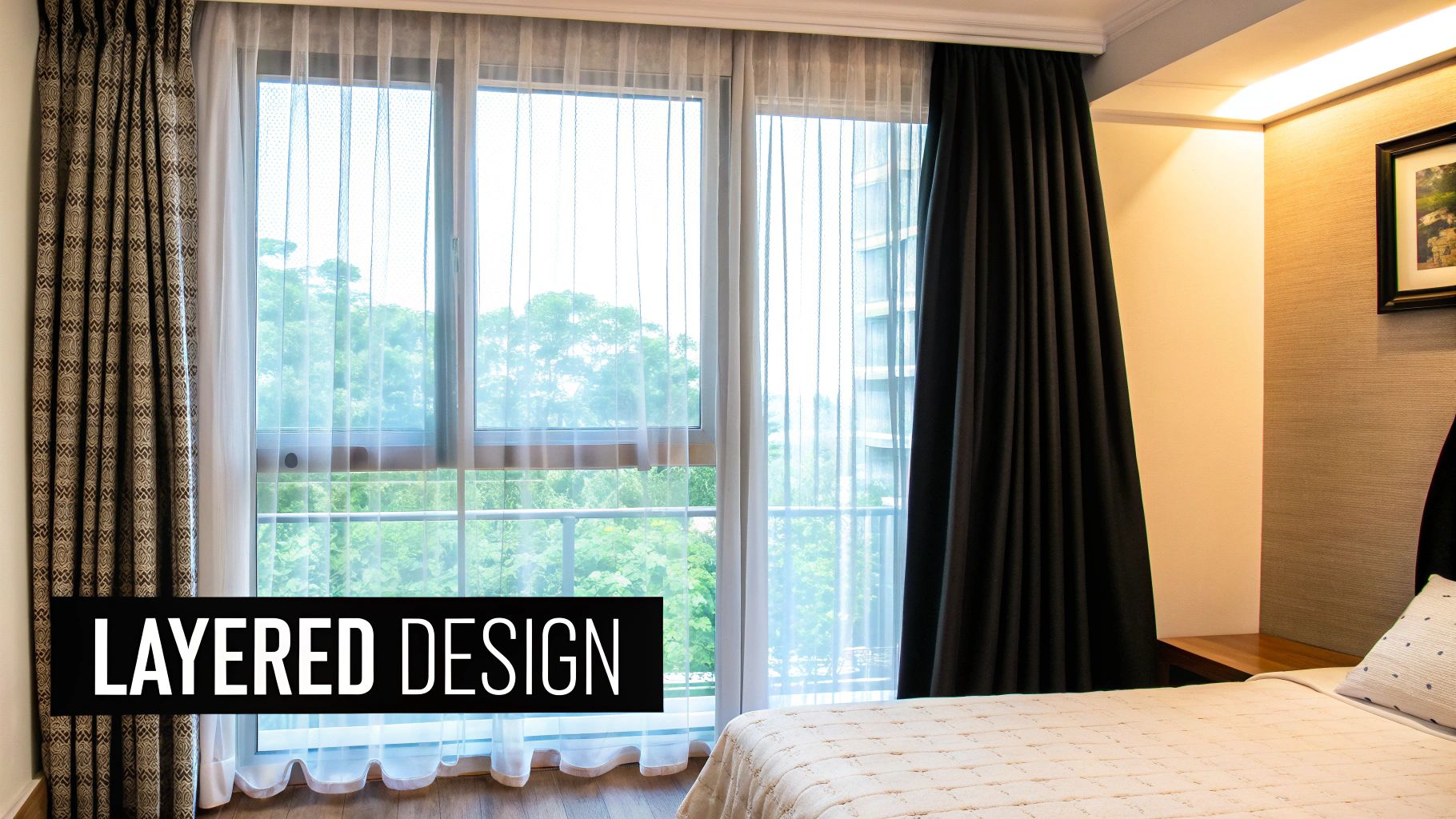
Curtains for Large Windows: 10 Ideas to Elevate Your Space
Large windows are the showstoppers of a home, flooding rooms with natural light. But dressing them? That can feel like a puzzle. The secret is balancing grand scale with practical needs like privacy and light control. This guide offers expert-backed curtains for large windows ideas to turn a design challenge into your home's most stunning feature.
We’ll explore the best fabrics, color strategies, and hardware secrets that designers use to make expansive windows look effortlessly chic, ensuring your choice is both beautiful and functional.
Table of Contents
- Why Do Large Windows Need Special Curtains?
- How to Choose the Right Fabric
- Mastering Color and Pattern
- Hardware and Mounting Techniques
- Smart Solutions and Layering Ideas
- Frequently Asked Questions
Why Do Large Windows Need Special Curtains?
A common mistake is treating a large window like a standard one, just scaled up. This rarely works because scale changes everything. A fabric that looks delicate on a small window can seem flimsy on a large one, and a standard rod might buckle under the weight of so much fabric.
What makes curtains for large windows different?
- Visual Weight: The sheer amount of fabric has a massive impact on the room's entire feel. It's a major design commitment.
- Functionality: Opening and closing heavy, wide curtains can be a workout without the right hardware or a motorized solution.
- Energy Efficiency: Those big glass panes can be a major source of heat loss or gain. The U.S. Department of Energy notes that window treatments can reduce heat gain by up to 77%, making your curtain choice a key factor in your home's energy efficiency.
When planning, draw inspiration from design philosophies like the Mediterranean interior design and its approach to natural light, which celebrates sunshine while providing shade.
Quick Guide to Large Window Curtain Solutions
This table summarizes the best ideas for tackling large windows, helping you match a solution to your primary goal.
| Primary Goal | Recommended Curtain Idea | Best For |
|---|---|---|
| Maximize Natural Light | Sheer or Linen Curtains | Living rooms and dining areas where privacy is less of a concern. |
| Enhance Grandeur | Floor-to-Ceiling Drapes | Rooms with high ceilings to create a sense of height and drama. |
| Ultimate Light Control | Layered Curtains (Sheers + Blackouts) | Bedrooms and media rooms needing flexibility for both light and darkness. |
| Easy Operation | Motorized or Smart Curtains | Very wide or tall windows that are difficult to operate manually. |
| Energy Efficiency | Thermal Insulated Curtains | Homes in extreme climates to help regulate indoor temperature. |
How to Choose the Right Fabric
The fabric is the heart of your curtains. For large windows, its impact is magnified, setting the entire mood of the room. A light, airy material creates a breezy feel, while a heavy, luxurious textile lends drama and formality. The right choice balances your style with practical needs.
Sheer fabrics like linen and cotton voile are fantastic for softening the view without blocking the sunshine. They act like a soft-focus lens for your window, diffusing harsh rays and casting a warm glow.
Balancing Weight and Function
On the other end of the spectrum are heavier materials like velvet, jacquard, and lined cotton. These provide substantial visual weight, superior insulation, and excellent light-blocking capabilities. The rich texture and deep folds can turn a large window into a stunning focal point.
So, how do you decide? Think about these key factors:
- Light Control: Do you want to gently filter light (sheers) or block it out completely (lined velvets)?
- Insulation: Heavier, lined curtains can make a real difference in your energy bills.
- Privacy: While sheers offer daytime privacy, they become see-through at night. Heavier fabrics provide complete privacy.
This decision tree can help you visualize which curtain goals align with different needs.

As you can see, your main objective—whether embracing sunlight, creating an intimate space, or making a bold statement—points you toward the ideal fabric.
Comparing Popular Fabrics for Large Curtains
To make the choice easier, here is a comparison of popular fabric options for large windows.
| Fabric Type | Light Control | Insulation | Aesthetic/Drape | Best Use Case |
|---|---|---|---|---|
| Linen | Sheer/Light | Low | Casual, airy, prone to wrinkling, soft drape. | Living rooms or dining areas where natural light is key. |
| Cotton | Moderate | Moderate | Versatile, crisp, clean look. Hangs well. | Any room needing a balance of light and privacy. |
| Velvet | High/Blackout | High | Luxurious, heavy, rich texture, dramatic folds. | Bedrooms, home theaters, or formal living spaces. |
| Silk | Moderate | Moderate | Elegant, shimmery, needs lining to prevent sun damage. | Formal dining rooms or bedrooms (with lining). |
| Polyester | High/Blackout | Moderate-High | Durable, wrinkle-resistant, fade-resistant, versatile. | High-traffic areas or windows with direct sun exposure. |
Durability and The Power of Lining
Durability is crucial, as large curtains are a significant investment and get lots of sun exposure. This is why synthetic fibers have become so popular. In fact, synthetics account for 71% of imports and 82% of exports in the global curtain market, largely because they hold up so well against fading.
Expert Tip: A lining is your curtain's secret weapon. It protects the main fabric from sun damage, adds body for a professional drape, and can offer thermal or blackout properties.
Explore these options in more detail by checking out our guide on different curtain cloth types for an in-depth comparison.
Mastering Color and Pattern
Your choice of color and pattern for large windows can completely define the space. Think of the fabric as a massive canvas. The right hue can make a room feel expansive and bright, or wrap it in a cozy embrace.
Solid curtains offer a clean, cohesive look that unifies a room. They gracefully step back, allowing your furniture, art, or the view to remain the star.

On the flip side, a patterned curtain can be the main event. In a neutral room, a bold, large-scale pattern can do the heavy lifting of a statement wall, injecting instant personality.
Choosing Your Color Palette
Color has a powerful effect on how a room feels. Light colors—whites, creams, soft pastels—make a space feel bigger and more open. They bounce natural light around, amplifying brightness.
But don't shy away from deeper tones. Colors like navy, charcoal, or deep emerald create a dramatic, sophisticated atmosphere. In a sprawling home, dark curtains can help carve out a cozy zone, like a seating area.
Designer Tip: When stuck, pull a color from an area rug, a piece of art, or throw pillows. Matching curtains to an existing shade is a foolproof way to get a coordinated look.
Making Patterns Work for You
If you choose a pattern, remember this: scale is everything. A tiny print can look messy and fade into a blur from a distance. On large windows, choose a large-scale pattern that has impact when viewed from across the room.
Here are a few pattern ideas that work on a grand scale:
- Vertical Stripes: A classic trick to draw the eye upward, creating the illusion of higher ceilings.
- Large-Scale Florals or Botanicals: Perfect for bridging the gap between your indoor space and the view outside.
- Geometric Prints: For a modern style, a large geometric pattern can introduce structure and dynamic visual energy.
Ultimately, it's about choosing a color or pattern that plays up your room's best features without taking over.
Hardware and Mounting Techniques
The unsung hero of any stunning window treatment is the hardware. For large, heavy curtains, the right support system is a structural necessity, ensuring they glide smoothly and hang beautifully.
A flimsy rod will sag, ruining the entire effect. That’s why investing in high-quality, durable curtain rods or track systems is essential when considering curtains for large windows ideas.
The High and Wide Mounting Secret
One of the most effective designer tricks is the "high and wide" mounting method. This simple adjustment can make your windows feel larger and your room taller.
Here’s the breakdown:
- Go High: Install the curtain rod at least 4-6 inches above the window frame. For more drama, aim for halfway between the frame and the ceiling.
- Go Wide: Extend the rod 6-12 inches beyond the window frame on each side. This allows the curtains to stack back completely off the glass when open.
This approach maximizes natural light and keeps your view unobstructed. For a deeper dive, explore our guide on how to hang curtains properly.
Choosing Your Hardware Style
The hardware is a key decorative element that should complement your room's overall vibe.
- Decorative Rods: A classic choice available in endless finishes, from matte black to brushed brass.
- Traverse Rods: Excellent for very wide or heavy curtains, using internal clips that slide along a track with a cord or wand.
- Ceiling-Mounted Tracks: For a minimalist, seamless look, this allows curtains to hang from ceiling to floor without visible hardware.
Safety First: For extra-wide windows, always use a rod with one or more center support brackets. This is critical to prevent bowing and ensure a safe, secure installation.
Smart Solutions and Layering Ideas
Modern homes call for smart and dynamic solutions. For large windows, this means creative and tech-savvy ideas that blend high style with effortless functionality.
Automation is a life-changing idea for large windows. Motorized curtains are a game-changer, especially for soaring or hard-to-reach windows. Imagine controlling light and privacy with a button or voice command.

The demand for smart curtains is rising as more people focus on energy efficiency. Projections show the global market for window coverings could hit USD 57.6–58.5 billion by 2034, with significant growth from automated and thermal solutions.
The Art of Layering for Ultimate Control
Layering window treatments is a designer-approved technique that offers unmatched versatility. The most classic combination pairs light sheers with heavy, opaque drapes.
- Sheer Curtains: During the day, the sheer layer diffuses harsh sunlight, filling your room with a soft glow while providing privacy.
- Opaque Drapes: At night, or for movie time, the heavier drapes provide complete privacy and darkness.
For a modern spin, layer curtains over roller shades or cellular blinds. If you want to get this look right, our article on how to layer curtains with sheers provides a detailed walkthrough.
Creative Ideas Beyond Traditional Drapes
Sometimes, the goal is purely aesthetic. Stationary panels are fixed curtain panels hung on either side of a large window just to look beautiful. They frame the view, add color and texture, and can make the window appear wider without ever obstructing the glass.
To plan ahead, you can visualize your interior design with 3ds Max to experiment with fabrics and styles, ensuring you land on a decision you’ll love.
Frequently Asked Questions
How high should I hang curtains on a large window?
The short answer is higher and wider than you think. The designer rule is to mount the curtain rod at least 4 to 6 inches above the window frame. For more drama, place the rod halfway between the top of the window and the ceiling. Also, extend the rod 6 to 12 inches past the frame on each side to maximize light and the view.
Are sheer curtains a good choice for large windows?
Yes, sheer curtains are a fantastic choice for large windows. They are perfect if you want to keep a room bright and airy while adding soft privacy. They diffuse harsh sunlight, casting a gentle glow without blocking the view. For ultimate flexibility, layer sheers behind heavier, opaque drapes.
What is the best way to cover an extra-wide window?
For an extra-wide window, a traverse rod system is an excellent solution. It uses a track and a cord or wand to glide curtains open and closed with ease. Alternatively, use a sturdy, long rod with multiple support brackets and hang several curtain panels (four or more) to cover the span. This creates a lush, full look and prevents the rod from sagging.
Should curtains on large windows touch the floor?
Yes, for a polished, high-end look, curtains on large windows should always reach the floor. Drapes that stop at the windowsill can make a wall feel shorter. You have three main length options: float (hem is ½ inch above the floor), kiss (hem just grazes the floor), or puddle (extra fabric pools on the floor). The "kiss" length is the most popular and versatile choice.
At Joey'z Shopping, we believe the right window treatments transform a house into a home. Explore our curated collection of curtains, shades, and hardware to find the perfect solution for your large windows.
Discover beautiful and functional window treatments at Joey'z Shopping
